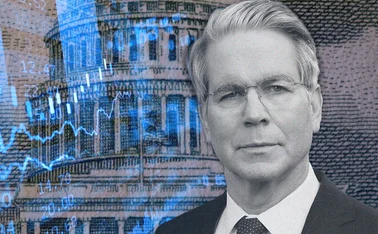
Asset management: outlook for 2019
Monetary policy divergence, protectionism and ESG are shaping reserve managers’ approach to 2019

It is clear which forces will shape the outlook for reserve managers in 2019 as they review their portfolios, strategies and policies. First, on the markets side there is policy divergence, with normalisation in the US and the threat of protectionism dominating geopolitical concerns. Second, and from an institutional perspective, reserve managers are increasingly including environmental, social and governance (ESG) and sustainability-related requirements in their investment approach. Both these factors speak to the long-term nature of reserve management investing, but also shorter term demands for performance and liquidity.
The first aspect, with rates rising in the US but steady in Tokyo and Frankfurt, is already generating volatility in markets, as Maria Ramona Santiago, senior assistant governor for financial market operations at the Central Bank of the Philippines, explains: “This policy divergence and a possible shift in monetary policies have generated more volatility in the asset markets, which becomes a great concern from a portfolio management perspective for the central bank community.”
Further uncertainty is added, she notes, with a geopolitical overlay: “The trade policies promoted by major economies have led to an environment of trade protectionism, which has a significant impact on the global trade and economic growth. Among the trade conflicts that emerged involved the Nafta and the Sino-US trade spat. A further escalation of trade protectionism will blow individual economies off course or weigh on equity markets in sectors that are particularly exposed to trade.”
How are reserve managers reacting? For Aniq Aziz, director of international markets and investments at the State Bank of Pakistan, rising rates will see a shift in focus: “Central banks were frequently looking for avenues to enhance return since the financial crises hit the markets and global interest rates bottomed out.
However, the search for new investment avenues has subsided, he says, as rates have risen in the US over the past 12–18 months. “The focus is now back on traditional sovereign assets and central banks are realigning their strategic asset allocations to fully benefit from rising interest rates in the US,” he says.
Portfolio shifts
But how will this translate into portfolios and, specifically, assets invested in? For Johanna Lasker, head of central banks and official institutions at BNP Paribas Asset Management, which was placed third for overall services in the poll, there is a mixture of the old and the new. She explains: “Looking back at the past year in particular, we have funded new mandates in short-duration fixed income, the traditional hallmark of a reserve portfolio, inflation-linked and US agency mortgage-backed securities (MBS) strategies. We have also started managing quantitative fixed income for central banks – a very interesting addition to the evolution of reserve management.” Into next year she expects to see continued interest in the US agency MBS and inflation markets, “which will continue to provide yield and diversification to the portfolio”.
Renewed interest in US agency MBS was a clear trend in 2018, agrees Jean-Jacques Barbéris, executive committee member, co-head of institutional clients coverage at Amundi Asset Management, which was placed fourth for overall services by central bankers, bringing diversification to dollar holdings and capturing the yield premium relative to treasuries. He also noted “a surge in interest for emerging market debt (both hard and local currency) as a diversification and return instrument”.
Looking ahead, says colleague Frédéric Samama, co-head of institutional clients coverage, the risk of interest rate hikes in the US and in Europe for 2019 is likely to remain a point of attention given the generally high share of fixed income assets in central banks’ reserves. “Floating rate fixed-income strategies could provide interesting interest rate risk mitigation benefits in this context,” he suggests. Amundi Asset Management expects central banks to continue to integrate passive equity solutions, he adds, alongside equity and fixed-income smart beta solutions providing drawdown management capabilities in line with the reserves stabilisation objective.
A case for equities
Equities will clearly have a role to play. “It seems to me there is increasing demand to be exposed to equities,” notes Jan Schmidt, executive director, risk management and transactions support at the Czech National Bank (CNB). The Czech central bank is a pioneer among central banks in equity investing, first building its portfolio soon after the crisis.[i] “Of course there are many forms, he adds, “like cash instruments, ETFs, futures, mutual funds, but the idea is the same: to diversify from the pure fixed income.” For central banks, such a view would once have been regarded as heretical, but as Central Banking surveys have shown, reserve managers have actively embraced the class.[ii]
Today, central banks typically look to access the equity market beta: this provides some diversification and return enhancement to what are still predominantly high credit quality fixed-income portfolios, explains Michael Cross, global head of official sector institutions at HSBC Global Asset Management, which central bankers ranked fourth for equity services. In practice, this usually means passively-managed strategies benchmarked to market capitalisation-weighted indexes in the first instance, he notes. Reserve managers tend to be wary of active approaches, he adds, being “sceptical of the ability of active management to add value net of fees in what they think of as efficient developed economy markets”.
Looking to 2019, factor-based approaches will come to the fore, says Cross. “Like purely passive management, multi-factor investing has the advantages of a systematic approach to portfolio construction and low management fees; and in addition it offers the potential to provide an incremental increase in return for an incremental increase in tracking error.” One large central bank equity mandate is in precisely such a strategy, he notes, with the client regarding this as an enhanced version of passive investing. “This will be the big growth area with central bank equity investors in 2019,” he says.
Central Banking’s new leaders
Leaders in Reserve Management Services 2018 is the first in a new series of Central Banking industry polls. The aim – as with all Central Banking’s surveys of reserve management over the past 20 years – is to provide a service to reserve managers, their management and stakeholders that they find useful. Leaders is new as it is the first time Central Banking has asked for a view of service providers, who reserve managers interact with on a regular basis and who add value to reserve management. To this end, the tables in this article display the top 10 institutions for each category, according to the audience polled.
In October 2018, Central Banking received 49 responses from central bankers in 35 central banks. Participants were asked to vote for their top three asset managers across six categories: overall services; fixed income; equities; knowledge transfer and training; benchmarking; and advisory. The votes were then scored, aggregated across participants and then ordered by size to generate the ranking. The percentage in the right-hand column represents the company’s share of the aggregated votes.
In this sense, the poll should be considered a reflection of how central bankers view providers of reserve management services. It is not designed to reflect volumes traded in any particular market and is therefore not necessarily a direct reflection of market share. When aggregating votes, Central Banking looks to strip out what we consider to be invalid votes. These include: people who clearly do not work at a central bank; multiple votes from the same person or IP address; proxy votes; “block votes” from groups of people on the same desk at the same institution voting for the same firm; and votes that place the same firm indiscriminately throughout the poll.
Central Banking will publish further polls in the Leaders series, both within reserve management services and other areas.
Safety first?
That said, recent months have seen an increasing interest in gold as Schmidt notes, with Hungary’s eye-catching purchase grabbing the headlines.[iii] Safety is the driving force as Slobodan Šojić, a senior adviser in the reserve management team at a Central and Eastern European central bank, observes. “Trade barriers, economic and political crises, which significantly affect the global instability of the financial markets, at the same time encourage central banks to invest more in the safest asset class in their reserves.”
So will it be a return to safety, or stick with diversification? Perhaps that question misses the point, as reserve managers will focus on the efficiency of their reserves. Matthew Mosca, head of strategy at BlackRock Official Institutions Group, which central bankers placed first for overall services, explains: “In a world where the range of return outcomes is wider, influenced by many potential shocks and factors, care and caution must be used when constructing a reserve portfolio. In 2019, we expect central banks will continue to explore ways to make their reserves more efficient.”
He cites five factors that will contribute to this in 2019: sustainability, including ESG; flexibility in managing fixed-income exposures; diversifying asset classes, particularly for those institutions with excess and/or growing reserves; efficient allocation of factors vs only focusing on static asset class views; and sophisticated technology to enable robust investment and risk management.
ESG to the fore
The second factor impacting reserve managers is sustainability and ESG. “There seems to be a wave of interest in ESG-related investment initiatives including green financing/investing,” says Santiago of the Central Bank of the Philippines. Central Banking surveys have identified this trend: while actively including ESG in investment was the preserve of a select few reserve managers in early 2018, active interest in the area was significantly higher.[iv] “In 2019 we expect to see more interest in sustainability and central banks looking at how to incorporate an ESG policy into their investment portfolio,” says Lasker, who notes that this is a particular focus for passive equity.
A key element of this is climate change. “The Network for Greening the Financial System is the 2018 game changer,” says Samama at Amundi. This group recognised that “climate-related risks are a source of financial risk” and so is a part of a central bank’s mandate. “By having central banks putting climate change on their agenda, it sends a very strong signal to all investors that they should do the same. It has already been the case for many over recent years, but it clearly accelerates the mainstreaming,” he adds. There is a trend to include reserve management under the sustainable, green, ESG type of investment approach, agrees the CNB’s Schmidt. “It comes from the external asset managers, it comes from some central banks themselves, it springs from every corner.” For reserve managers, the challenge will be how to add this to the lengthening list of factors they must take into consideration when investing.
Benefits of competition
“We have seen a more competitive environment in the asset management industry; fees have diminished in recent years,” notes Bernardita Redondo, head of assets and liabilities management at the Central Bank of Costa Rica. Central banks could take advantage of this situation (smaller asset manager fees) at least in two ways, she says: first, they can have several external managers with different investment philosophies and mandates and compare the results among them; and, second, it is easier for central banks to invest in new asset classes and increase the diversification of the portfolio.
The current higher rates perhaps will allow central banks to take more risks and look for training in order to improve skills as asset managers, perhaps through external managers.”
Training is a key part of the relationship, but it too has undergone change, as Johanna Lasker of BNP Paribas, notes. “The request for training has intensified and become more tailored and technical – a very welcome development.”
BlackRock’s Mosca agrees, noting his firm offers advice and support on stalwart areas such as asset allocation, portfolio construction, sustainable investing and risk management, “as well as implementation of new asset classes in reserve portfolios”.
[i] See “Equity risk: a central banker’s view”, by Jan Schmidt in Pringle R. and N. Carver (eds), HSBC Reserve Management Trends 2014, (London: Central Banking Publications) 2014.
[ii] See table on page 38 in chapter one of Pringle R. and N. Carver (eds) HSBC Reserve Management Trends 2018, (London: Central Banking Publications) 2018.
[iv] See page 23 in chapter 1 of Pringle R. and N. Carver (eds), HSBC Reserve Management Trends 2018, (London: Central Banking Publications) 2018.
Only users who have a paid subscription or are part of a corporate subscription are able to print or copy content.
To access these options, along with all other subscription benefits, please contact info@centralbanking.com or view our subscription options here: subscriptions.centralbanking.com/subscribe
You are currently unable to print this content. Please contact info@centralbanking.com to find out more.
You are currently unable to copy this content. Please contact info@centralbanking.com to find out more.
Copyright Infopro Digital Limited. All rights reserved.
As outlined in our terms and conditions, https://www.infopro-digital.com/terms-and-conditions/subscriptions/ (point 2.4), printing is limited to a single copy.
If you would like to purchase additional rights please email info@centralbanking.com test test test
Copyright Infopro Digital Limited. All rights reserved.
You may share this content using our article tools. As outlined in our terms and conditions, https://www.infopro-digital.com/terms-and-conditions/subscriptions/ (clause 2.4), an Authorised User may only make one copy of the materials for their own personal use. You must also comply with the restrictions in clause 2.5.
If you would like to purchase additional rights please email info@centralbanking.com test test test







